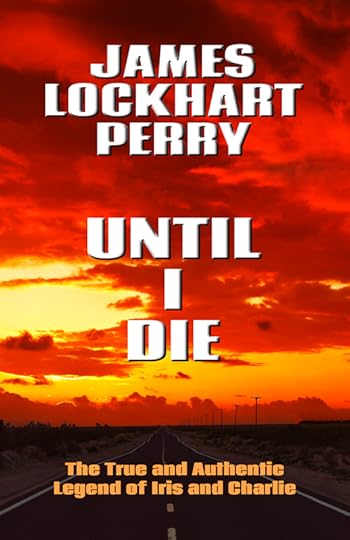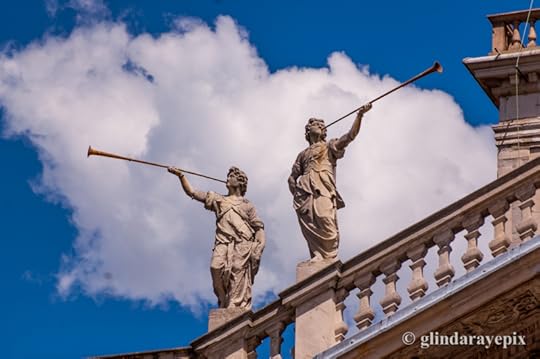James Lockhart Perry's Blog, page 10
August 11, 2016
Carrara
Our coolest photo shoot ever took us to the Fantiscritti marble fields in the hills above Carrara, in Tuscan Italy, in search of the hole the quarrymen left in 1464 when cutting out the marble for Michelangelo’s David. Within minutes, we were soaked to the bone by the driving winter rains. The road up to Collonnata ran right through the quarries so, other than an occasional warning siren, there were no restrictions on movement. The greatest photographic challenges, in fact, were dealing with slow shutter speeds and constant vibration from the blasting that continued all afternoon around us.
Michelangelo famously spent months at a time in the quarries of Italy searching out the perfect block of marble for his latest statue, but in the case of the David, he was actually the third sculptor to tackle this particular hunk of stone. Agostino di Duccio and Antonio Rossellino both chopped away at it before Michelangelo finally talked the Florentine city fathers into letting him try his hand. The project took him two years and was unveiled on 8 September, 1504, on the Piazza della Signoria outside the Palazzo Vecchio. From that spot, the original and its replica have spent the last five centuries staring southward at the Goliaths of Rome and daring them to take on the independent republicans of Firenze.
Nowadays, the quarrying in Carrara is all done by machine, and by far the biggest use of the gorgeous stone is for gravel. But it isn’t hard to picture the old ways, with many a stone quarryman’s hut still hanging off the mountainsides with ancient knives, saws, hammers, and chisels affixed to the walls. Those quarrymen were nearly all anarchists and turned the tiny metropolis of Carrara into one of the 19th Century’s most influential hotbeds of European radicalism. Their spirit survives today in Toscana’s reputation for crazy and contrarian politics.
After centuries of chipping away, the mountainsides have receded, so we’re pretty sure the hole in the photo gave birth to a more modern statue gracing some obscure piazza in some obscure European city. But still, you can feel the ghosts of Michelangelo and his contemporaries all over these valleys.


Filed under: Travels Tagged: Italy, Travel

August 9, 2016
Until I Die
Elegant beauty or not, Iris Brodsky is a 76-year-old walking catastrophe. She can’t even get her corpuscles to flow properly. Everyone assumes she’s crazy, but, in her humble opinion, that still doesn’t give them the right to call her a murderer.
She finally convinces Charlie Hamilton, that charming 45-year-old widower from the police department, that her late husband was the vicious Bulgarian spy she always claimed. Her own innocence, of course, is an altogether more complicated matter.
Charlie has his own reasons for believing in Iris and spirits her away just in time from the clutches of a publicity-hungry law enforcement establishment. But from the first inch of their transcontinental odyssey onward, the colorful pair inadvertently breaks one law after another. Not the most constructive of strategies, but it still doesn’t qualify either of them as a criminal. Or does it?
 Available in paperback and eBook from Amazon.
Available in paperback and eBook from Amazon.Until I Die
The True and Authentic Legend of Iris and Charlie
Part I. Femme Futile

Chapter 1

Not many people dream of corpuscles, but Iris Brodsky did. Oversized, crimson, square corpuscles tobogganing one after the other through her bloodstream, snagging in the twists, turns, and intersections of her veins, blocking the gentler, white-coated variety from the execution of their daily rounds, and coagulating everything into a sluggish, ice-cold suspension like crystalizing red buttermilk. Yet when Iris still managed to pick up the phone to call her doctor—the young Cary Grant she misrecalled from her long forgotten teens—Doctor Grant refused to panic. Square corpuscles were an anatomical impossibility, the careful physician explained in his prim and precise English. If anything, the tiny, three-dimensional goodies had to be cubes. There really was nothing to worry about.
Nonetheless, Iris fretted all the way across town to the sympathetic therapist—the young Jimmy Stewart, of course—recommended to her by the disturbingly feminine Doctor Grant. In the taxi she imagined taking these days—ever since that giggling, wild-eyed Ernest Borgnine at Motor Vehicles yanked the license out of her hand—she could feel the elastic skin underneath her shocking red dress popping, pulsing, and straining under the punishment of the once square, now cubed, corpuscles. Not that the hyperactive cells exactly hurt—no, they were more a source of embarrassment. After all, who suffered from cubed corpuscles in this modern, health-conscious age?
“So has anything significant happened in your life?” the ephemeral Doctor Stewart inquired with the solicitous knit of his brows that had set so many earlier femmes fatales to swooning.
“Well, my husband died last week.”
“Besides that, I mean. Any major changes?”
“I don’t know… I did go to the grocery store on Monday instead of Tuesday.”
“Hmmm. Why would you do that?”
“My husband insists on fresh fish, and the fish swam in a day early this week.”
“But didn’t you just describe him as deceased?”
“It’s hard to say, really. And it was a salmon. I’m not sure how you tell the sex of a salmon.”
“No, I was referring to—”
“Oh! My husband. Not much to say about him. Like I told you before, there was a time when I believed he wore an angel’s wings—at least I might have. Not a bit like what they’ve been saying.”
“And who’s been saying what about him?”
“That all along he was a wife-beater, maybe even a traitor and a spy. Until he wasn’t, of course. That nice young man from the police force—”
“The John Wayne?”
“Yes, as a matter of fact, at least the younger version without the eye patch. It was his idea that my husband tore the cyanide cocktail out of my grasp to quench his thirst. Cyanide looks so much like vodka, young man, although, as a practicing therapist, you probably already knew that. In spite of his many fine features, my husband could be quite rude about stealing my drinks.”
“So you didn’t deliberately murder him.”
“Heavens! Why would I do something like that? It was so much easier to let him kill himself.”
The young Doctor Stewart hemmed or hawed—Iris couldn’t quite decide which—and pored over his notes with a bitten number five pencil in his scribbling hand. Which gave her an opportunity to open her eyes and inspect the white bedroom ceiling with the crack in it she’d been meaning to fix since forever. The crack reminded her of the Mississippi delta, the way it had spread over the years, trickling out of the northwest corner and flowing through several lazy, flat, humid oases before it let out into the cobweb-infested chandelier. When her husband was younger, he would have noticed and given her a well-deserved smack for neglecting her wifely duties like that. But now, of course, he could see nothing—or everything, depending on his choice of religion—so Iris was either doomed or home free.
But at least she was home. And the strangely malodorous, gargling-clacking false-teeth noises from the bathroom reminded her to close her eyes and feign another five minutes of sleep before the fiend donned the crude and tacky boxer shorts he insisted on wearing around the house and disappeared into his basement workroom. She’d have to ask the young Doctor Stewart about that in a future dream. What good did it do to poison a dentured monster, if he was just going to show up again the next morning as if nothing had happened?
“What time is it?” Iris asked herself, either silently or aloud—she could never be sure which—and gazed out the filthy bedroom window at the dead oak in the side yard. A withered, yellowing leaf had sprouted out of one of the cross arms of the naturally abstract crucifix and set her to pondering the meaning of horticultural mortality. In spite of her grittiest efforts, the forlorn leaf had already survived two winters all alone, fluttering in the breeze, dripping with rain and melting ice, neither living, nor removed to the other side. As far as Iris knew, it wasn’t supposed to work like that. Leaves, trees, insects, animals, and even the occasional human were supposed to live until they died.
“What time is it?” Iris asked again, but still no answer. Of course, she already knew the solution to that daily conundrum. Her husband, the real and persistent version, was a human metronome with a built-in timer that had turned on and shut down at seven AM and nine PM every day for the last fifty-three years and counting. If she had her way, he would never gasp a breath of their fifty-fourth jamboree.
Yes! Iris laughed happily, at last a decision! Except that she’d reached this same Rubicon too many times to recall, only to lapse into her usual weakened, bitter, passively aggressive role. For the millionth time, she held her breath and listened for the tread down the stairs, the sudden blind stumble, the long awaited crash of the hallway bannister smashed to pieces by that hideous, aging body in flight. Instead, a distant door slammed and left her alone in the bedroom with the cracked white ceiling to feel her arms for rushing cubes of rancid, blood red buttermilk.
At least she was still alive and at home and not cast out on the sidewalk like a poor, starving Calcutta beggar. A beggar without a husband to despise, that was. An unfettered woman with a battered tin cup, a National Geographic glower the color of smoking embers, and a child-sized wisp of pretend-eternity hanging off her hip. Iris reminded herself to check on flights to India, except she already knew she’d missed this morning’s departure. She’d missed it every morning for the last fifty-three years and counting.
 Available in paperback and eBook from Amazon.
Available in paperback and eBook from Amazon.Filed under: Novels Tagged: California, Nevada, New Mexico, New York, Ohio, Pennsylvania

County Sligo
Just another day in paradise? It would be, especially under this surreal pre-storm atmosphere, except… In Ireland, you can never entirely separate Yeats’ “terrible beauty” from the historical events that for centuries made it such a horror show of British misgovernment.
Small farms like this one in County Sligo would have suffered grievously in the repeated potato blights and needless famines that afflicted the Emerald Isle throughout the 19th century under Anglo rule. While Irish families died and emigrated by the millions, the British authorities were shipping food by the ton—nearly 4 million litres of butter alone in 1847—under armed guard to the ports for export to England. And as if that wasn’t bad enough, the Anglo aristocracy took advantage of the mess to evict thousands of families with nowhere else to go. Aristocrats like the Earl of Lucan and the Marquis of Sligo enriched themselves by turfing out starving peasants, burning down their houses, and converting the land to grazing for their more profitable sheep and cattle.
If ever an oligarchy lost the Mandate of Heaven, this was it, even if the British managed with guns and cannon to hold on for another half-century. But outrage aside, the United Kingdom’s loss was clearly America’s gain. While the Irish population shrank by 25%, emigrants flooded the eastern shores of Canada and the United States and helped invent and build the modern American city. In the Civil War, the Irish Brigade volunteers earned their citizenship the hard way with more than 60% casualties at Antietam and Fredericksburg. And then there were the Presidents Kennedy, Reagan, and Clinton.
It is a wonder and a testament to character that even today the Irish are not angrier. Yet there is no friendlier and more tolerant and welcoming people for a visitor, especially from America. So yes, the island is a kind of paradise—at least until the next rain storm pours down on your vacation. But if that happens, there are plenty of warm pubs waiting to cheer you up.

Filed under: Travels Tagged: Ireland, Travel

August 7, 2016
New Orleans
From 1897 until 1917, “Sporting Houses” were not only legal in New Orleans, they provided the city with its largest and most reliable income source. Tourists were sold Blue Books listing every available woman in town by race. For a license fee of $100 per courtesan and $250 per madam, anyone could operate a house catering to the resulting flood of cash-only amours.
Upscale houses like this one on Bourbon St.—supposedly the last to close—provided forage for carriage horses on the ground floor. By law, female companionship was limited to the upper stories, and unlike today, flaunting and boozing on balconies were strictly prohibited. And in spite of strict segregation of the “labor force,” most grand houses sported a negro band where many of America’s most famous jazz musicians, including Louis Armstrong, got their start.
My novel, The Quotidian, includes a scene that takes place in the elegant gay bar and art gallery across the street from this particular establishment. Our host regaled us with some of the choicer stories, even as we all realized that the reality was undoubtedly a little more ghastly than the legend. But what the hey—with enough time, you can probably polish any fragment of history, however squalid the original. The city of New Orleans certainly thinks so.

Filed under: Travels Tagged: Louisiana, Travel

August 6, 2016
Bruxelles
For people who bemoan the state of US politics, Belgium provides an instructive example. The usual Left, Center, and Right political parties are each divided by ethnicity into French Wallon and Flemish, producing six major enduring parties and a host of splinters. Things get so bad that the country goes months (and in 2014 even a year) without forming any central government at all.
Yet through all the hubbub, the Belgian economy has grown into one of the richest in the world. Bruxelles (or Brussel or Brussels) has been transformed from the backward provincial capital I used to know into the political and social leader of Europe. Relative to the exhausted country that dragged itself out of the post-war doldrums and barely survived the 1950s, the current scene breathes prosperity and industriousness.
The solution is pretty simple too. Other than the police and tax collectors, the Belgians ignore their politicians. Most citizens barely recall the name of the Prime Minister, let alone what he stands for. 90% of the people you meet identify with neither country, nor ethnicity, nor region, nor even city, but with neighborhood and family. Government bureaucrats seem to get and even share this attitude, and it shows in the way they generally stay out of the way.
You can do pretty much anything you want in this country. People just don’t give a damn, and yet the sky never quite falls in.
[image error]Brussels, Belgium, Europe
Filed under: Travels Tagged: Belgium, Travel

August 3, 2016
Woluwe-St.-Pierre
This shot of our neighborhood in Bruxelles says everything about the Belgian dilemma. In the distance, le Cinquantenaire, a massive memorial to 50 years of Belgian independence built out of the profits of Congolese slavery. In the foreground, Field Marshall Bernard Montgomery surveys the parks and boulevards he liberated from the Nazis in 1944. Most Bruxelloises have gladly forsaken both eras in favor of their current status as an international city, especially here in the heart of the European Union Quarter.

Filed under: Travels Tagged: Belgium, Travel

July 31, 2016
Mondorf-les-Bains
In May of 1945, as news reports then had it, all of the top Nazi leaders vanished from the face of the earth. Hermann Göring, Joachim von Ribbentrop, Wilhelm Keitel, Julius Streicher, all of them gone. No one knew that they had been whisked away to the hidden resort that is today our favorite spa in all of Europe, l’Hôtel du Palais at Mondorf-les-Bains in lower Luxembourg.
Central Continental Prisoner of War Enclosure No. 32, or Camp Ashcan, as the Americans designated it, was the interrogation center where the legal cases were built that sent so many of the top Nazis to the gallows. Security was so tight that not even the exterior guards knew the identities of their charges. One of the key interrogators, Lt. John Dolibois, only found out why he was there when he was checking into his room and was interrupted by Reichsmarschall Göring turning in an extra uniform.
Unusual for any camp in the war years, the security at Ashcan—guard towers, an electrified fence, and khaki netting over all—was designed not to prevent escape, but to protect the inmates from the revenge of an infuriated world. Yet the Nazis themselves refused to believe that they were going to be put on trial at all. To a man, they saw nothing particularly wrong with what they had done.
Today, in the same place where the Class of ’45, as the Americans called them, were finally stripped of their false dignity and grotesque illusions, we start off mornings with a swim in the outdoor hot baths, followed by a three course lunch, then saunas from 70 to 85 degrees Celsius, and finally, after another swim, a three-course dinner in our local favorite, le Café de Paris. The Bordeaux on the wine list are fabulous.
But it doesn’t feel particularly spooky. Facilities that withstood the depredations of two World Wars still fell in 1985 to that most implacable of demolition derbies, the modern European urban renewal plan. Today, the shuttered restaurant in the photo is all that remains of the original spa. Not that we’re complaining–Trotsky didn’t call it the Dustbin of History for nothing. Some people and their remnants just seem to belong there.

Filed under: Travels Tagged: Luxembourg, Travel

July 27, 2016
Bruxelles
That aging grand dowager of Bruxelles, the Hotel Metropole, has enormous historical significance, considering the minor capital in the tiny country it dominates.
In late July of 1903, a bunch of obscure and excruciatingly long-winded Russians took tea here as they plotted the 2nd Congress of the Russian Social Democratic Labour Party, held in an abandoned grain warehouse north of the city. Before the Belgian police expelled them to London, Vladimir Lenin split the party, gave birth to the Bolsheviks, and set in motion events that would shatter the world order in the Russian Revolution of 1917.
In October, 1927, seventeen future Nobel Laureates, from Marie Curie to Niels Bohr and Albert Einstein, gathered here for the Fifth Solvay Conference that shattered our understanding of the physical world. Einstein had invented quantum theory and quantum mechanics, but now tried to walk them back when Walter Heisenberg drew the obvious, if atheistic conclusion with his Uncertainty Principle that life is a random and ultimately godless series of events (and yes, I’m paraphrasing).
Einsten famously replied, “God does not play dice!”
Bohr famously replied, “Einstein! Stop telling God what to do!”
And then there was the 1949 invention here of the Black Russian cocktail by the barman Gustave Tops at the behest of the American Ambassador, Perle Mesta. Five parts vodka to two parts coffee liqueur, to render the victim equal parts drunk and neurotic.
From the day it opened its doors in 1895, all the Metropole wanted to do was sell its owners’ selection of beers. But in a tiny, neutral country with a tolerant population and an easy-going police force, it soon became known as a faintly seedy, if expensive nest of spies, provocateurs, and exiled free-thinkers. When my mother first brought me here in 1963, we sat in the café with our stale Belgian coffee and mountainous pastries and carefully examined the faces around us for telltale signs of nefarious intent.
My mother could tell a great story. I was so enthralled that, a few weeks later, my friend Johnny and I charged through the opening gates of the Russian Embassy on our bicycles and rode around the courtyard, jeering at the (presumably) KGB guards and chauffeurs who chased us out. Fortunately for me, my father thought it a hilarious escapade, but Johnny’s father, a senior NATO Colonel, grounded him for life.
That was my last direct involvement in high-stakes geopolitics. But if you should happen to go to the Metropole, I still recommend the strawberry tart with a mountain of whipped cream. There’s no telling what it will make you do.

Filed under: Travels Tagged: Belgium, Travel

July 25, 2016
Saronno
Back when we used to make a regular run from Lugano in Switzerland south to Milan, this obscure commune was a compulsory stop, if only to check out these two dudes atop the first church on the way into town. The Sanctuary of the Blessed Virgin of the Miracles was built in 1498, a year after the Madonna appeared to a local peasant, Pedretto Morandi, and told him to get after it.
Pedretto never achieved sainthood like his fellow compulsive church builder St. Francis, but that’s not surprising. Italy is full of these voluntarily built and financed monuments to grass-roots faith.
In Saronno, that faith had to withstand two plagues, several wars and invasions, and a massive fire that burned the commune to the ground. Yet in the end, it was prosperity and not misery that put paid to the centuries of prayer. At one time, the three great churches of Saronno struggled to serve just 5,000 inhabitants. Today, in a town of 39,000, they’re mostly empty.
 Concert in Saronno
Concert in SaronnoFiled under: Travels Tagged: Italy, Travel

July 24, 2016
Manassas
On July 21, 1861, exactly 155 years before Donald Trump accepted the nomination of the Republican Party last Thursday, the US Army set out into Virginia under some of the most ossified Generals in American history to take control of the Manassas railway junction and quell a disturbance among its southern citizens. Unfortunately, they ran into some of the finest Generals in American history, who had joined the revolt. For the Union, General Stonewall Jackson couldn’t have picked a worse day to earn his nickname. He single-handedly turned the tide here on Henry House Hill, saved the Confederacy, and changed a bumbling police action into a vicious and ruthless war.
That war eventually produced on both sides the greatest generation of military leaders in American history. They invented modern industrial warfare–their battle plans and logistics were still being studied 100 years later all over the world. But the key feature, IMHO, was just how angry their citizens were. I would agree with President Obama that Americans are not generally an angry people—in fact, they are one of the sunniest and friendliest communities on earth–but as both they and other belligerents have found, you really don’t want to piss them off.
Just saying…
 Manassas, Virginia, USA. The house on Henry House Hill, a key objective in the 1st battle of Manassas (Bull Run) on July 21, 1861, where Confederate General Thomas “Stonewall” Jackson earned his nickname, and a disorganized rebellion morphed into the world’s first modern civil war.
Manassas, Virginia, USA. The house on Henry House Hill, a key objective in the 1st battle of Manassas (Bull Run) on July 21, 1861, where Confederate General Thomas “Stonewall” Jackson earned his nickname, and a disorganized rebellion morphed into the world’s first modern civil war.Filed under: Travels Tagged: Travel, Virginia




